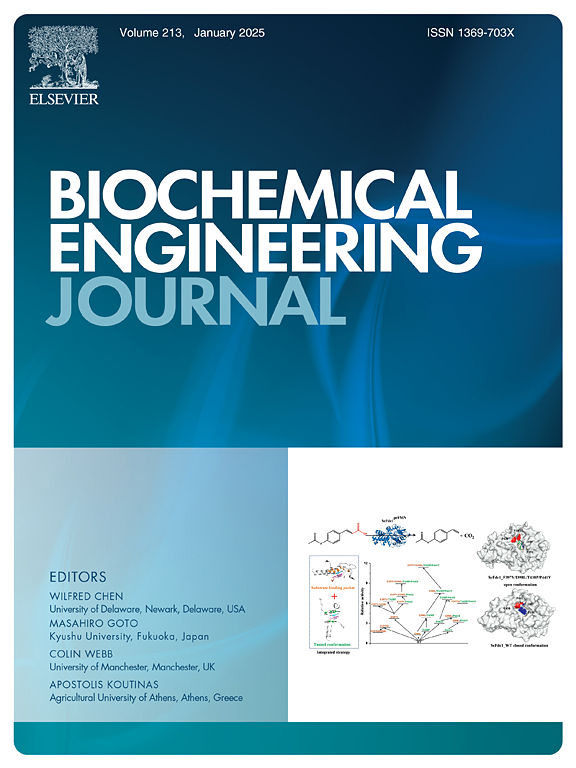一种建设性的自下而上的方法来阐述代谢网络:光合蓝藻Arthrospira spirina platensis PCC 8005的案例研究
IF 3.7
3区 生物学
Q2 BIOTECHNOLOGY & APPLIED MICROBIOLOGY
引用次数: 0
摘要
数学建模已被证明是理解微生物代谢的一种非常有效的工具,计算机和实验研究有助于量化细胞内机制,并为优化感兴趣的分子的生产铺平道路。在这种背景下,代谢网络的发展变得特别有趣,尽管它们的重建面临着挑战。虽然基因组规模网络的细化在计算上是昂贵的,但小型网络往往过于简化,重要的生物机制可能被忽略,这限制了它们在工业应用中的使用。为此,本研究提出了一种建设性的自下而上的方法来识别中等大小的代谢网络,通常由几百个反应组成。它将基本的生物学知识和一系列基于约束的方法结合在一个迭代策略中,使网络定义得以细化。该网络首先使用计算机数据进行验证,随后使用实验数据进行改进,以增强其生物学相关性。几个案例研究已经解决,以评估该方法的效率,并着重于光合蓝藻节肢螺旋sp. PCC 8005的建模。该方法是有效的,并提供了有希望的结果,代谢分析显示了网络的一致预测能力,与现有研究一致。本文章由计算机程序翻译,如有差异,请以英文原文为准。
A constructive bottom-up approach for the elaboration of metabolic networks: Case study of photosynthetic cyanobacteria Arthrospira spirulina platensis PCC 8005
Mathematical modeling has proven to be a highly effective tool for understanding microbial metabolism for which in-silico and experimental studies help to quantify intracellular mechanisms and pave the way for optimizing the production of molecules of interest. In that context, the development of metabolic networks turns out to be particularly interesting despite the challenges underlying their reconstruction. While the elaboration of genome-scale networks is computationally costly, small networks are often oversimplified and important biological mechanisms might be omitted, which limits their use in industrial applications. For this purpose, this study proposes a constructive bottom-up approach for the identification of metabolic networks of intermediate size, typically comprised of a couple of hundred reactions. It combines basic biological knowledge and a series of constraint-based methods in an iterative strategy, enabling the refinement of the network definition. The network is first validated using in-silico data, and subsequently refined using experimental data to enhance its biological relevance. Several case studies have been addressed to assess the efficiency of the methodology, and this paper focuses on the modeling of photosynthetic cyanobacteria Arthrospira sp. PCC 8005. The procedure is effective and provides promising results and metabolic analyses show consistent predictive capabilities of the network, in concordance with existing studies.
求助全文
通过发布文献求助,成功后即可免费获取论文全文。
去求助
来源期刊

Biochemical Engineering Journal
工程技术-工程:化工
CiteScore
7.10
自引率
5.10%
发文量
380
审稿时长
34 days
期刊介绍:
The Biochemical Engineering Journal aims to promote progress in the crucial chemical engineering aspects of the development of biological processes associated with everything from raw materials preparation to product recovery relevant to industries as diverse as medical/healthcare, industrial biotechnology, and environmental biotechnology.
The Journal welcomes full length original research papers, short communications, and review papers* in the following research fields:
Biocatalysis (enzyme or microbial) and biotransformations, including immobilized biocatalyst preparation and kinetics
Biosensors and Biodevices including biofabrication and novel fuel cell development
Bioseparations including scale-up and protein refolding/renaturation
Environmental Bioengineering including bioconversion, bioremediation, and microbial fuel cells
Bioreactor Systems including characterization, optimization and scale-up
Bioresources and Biorefinery Engineering including biomass conversion, biofuels, bioenergy, and optimization
Industrial Biotechnology including specialty chemicals, platform chemicals and neutraceuticals
Biomaterials and Tissue Engineering including bioartificial organs, cell encapsulation, and controlled release
Cell Culture Engineering (plant, animal or insect cells) including viral vectors, monoclonal antibodies, recombinant proteins, vaccines, and secondary metabolites
Cell Therapies and Stem Cells including pluripotent, mesenchymal and hematopoietic stem cells; immunotherapies; tissue-specific differentiation; and cryopreservation
Metabolic Engineering, Systems and Synthetic Biology including OMICS, bioinformatics, in silico biology, and metabolic flux analysis
Protein Engineering including enzyme engineering and directed evolution.
 求助内容:
求助内容: 应助结果提醒方式:
应助结果提醒方式:


